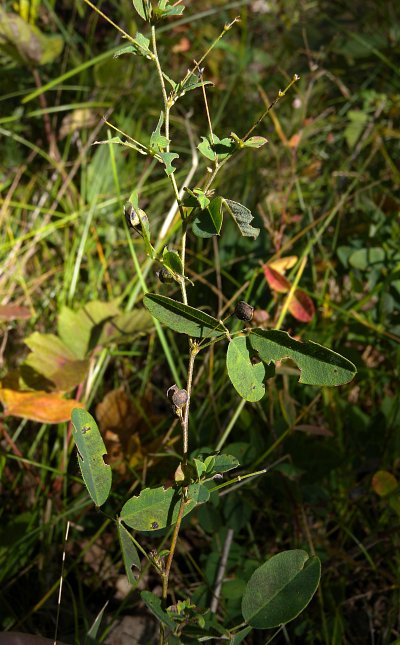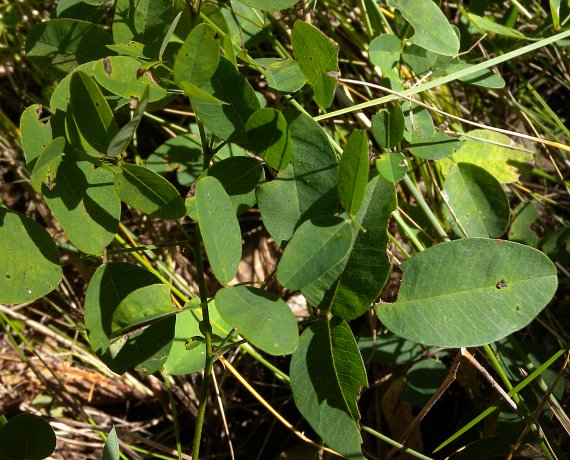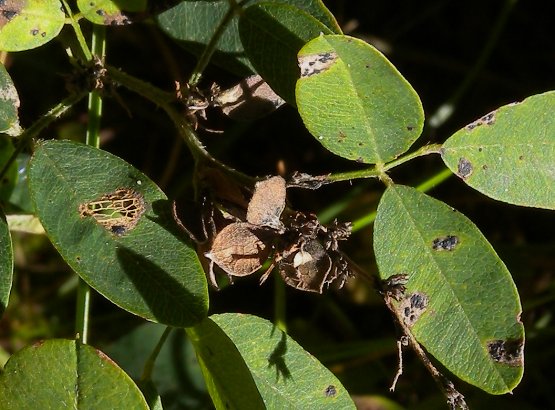
Racemes and/or sparingly branched panicles of 3-8 flowers are produced on long ascending peduncles from either the axils of upper leaves or directly from the upper stems. These peduncles extend beyond the compound leaves. The inflorescences are also produced from the axils of middle leaves, although their peduncles tend to be about as long as the petioles of compound leaves. Each flower is about 6-10 mm. in length, consisting of a light green calyx with 5 teeth, 5 whitish purple to purple petals, 10 stamens, and a pistil with a single style. The flowers have a typical pea-like floral structure, consisting of a large upright banner (upper petal), a pair of wings that are slightly spreading and extend forward (2 lower outer petals), and an inner keel that extends forward (2 lower inner petals). The wings of each flower are slightly shorter than its keel. At the base of the banner, there is an arch-shaped patch of dark rosy purple. The calyx is sparsely appressed pubescent and it extends to about one-half of the length of the flower. The pedicels of the flowers are short (1-4 mm. in length). In addition to the preceding chasmogamous flowers, there are also inconspicuous cleistogamous (self-fertile) flowers that develop from the axils of the leaves. These cleistogamous flowers are held close to the stems on short pedicels (1-4 mm. in length). The blooming period occurs from mid- to late summer, lasting about 1 month.

Afterwards, fertile flowers are replaced by small seedpods that become 4-7 mm. long at maturity, the latter changing in color from green to dark brown. Usually, the chasmogamous flowers don't produce seedpods, while the cleistogamous flowers almost always do. The seedpods are orbicular-ovate in shape and flattened, tapering abruptly at their tips into short beaks; they are sparsely appressed-pubescent along their sides. Each seedpod contains a single reniform (kidney-shaped) seed. The root system consists of a taproot.
Cultivation: The preference is partial sun, dry-mesic conditions, and somewhat sterile soil containing some clay or rocky material. Competition from taller and more aggressive ground vegetation is not well-tolerated. This legume fixes nitrogen in the soil.
Range & Habitat: The native Violet Bush Clover is occasional in the southern half of Illinois, while in the northern half of the state it is uncommon (see Distribution Map). However, it can be found in scattered areas throughout the state. Habitats include upland rocky woodlands, thinly wooded bluffs along rivers, upland savannas, hill prairies, dry grassy openings in upland woodlands, and roadside embankments along hilly woodlands. Violet Bush Clover is found primarily in average to high quality natural areas. It probably benefits from occasional wildfires that reduce competition from woody vegetation.

Faunal Associations: The chasmogamous flowers of Violet Bush Clover are cross-pollinated primarily by bees, including leaf-cutting bees (Megachile spp.), digger bees (Melissodes spp.) and Halictid bees. Small butterflies and skippers may also visit these flowers, but they are less effective at cross-pollination. The showier chasmogamous flowers of Violet Bush Clover probably require insect cross-pollination before they can produce seedpods, while the cleistogamous flowers do not. Miscellaneous insects feed destructively on the foliage, seeds, and other parts of bush clovers (Lespedeza spp.). These insects include the seed-eating larvae of a weevil (Coelocephalapion decoloratum), various leaf beetles and their larvae (Anomoea laticlavia, Odontota horni, Phyllecthris dorsalis, etc.), foliage-eating larvae of a sawfly (Atomacera debilis), seed-eating broad-headed bugs (Alydus spp.), an aphid (Microparsus singularis), the Prairie Walking Stick (Diapheromera velii), and Tick Trefoil Thrips (Neohydatothrips desmodianus); see Sauer (2005), Clark et al. (2004), Smith (2006), Schaefer (1980), Blackman & Eastop (2013), Arment (2006), and Stannard (1968). The caterpillars of some skippers feed on the foliage of bush clovers; these species include the Hoary Edge (Achalarus lyciades), Southern Duskywing (Thorybes bathyllus), and Northern Duskywing (Thorybes pylades). In addition, the larvae of some moths feed on these plants. Examples of such moths include the Bella Moth (Utetheisa bella), Common Ptichodis (Ptichodis herbarum), Black-spotted Prominent (Dasylophia anguina), a Cosmopterigid moth (Triclonella pergandeella), and a Gracillariid moth (Parectopa lespedezaefoliella); see Opler & Krizek (1984) Covell (1984/2005), and Needham et al. (1928). The larvae of the last two moths are leaf-miners. Among vertebrate animals, the seeds of bush clovers are eaten by the Ruffed Grouse, Wild Turkey, Bobwhite Quail, Mourning Dove, and Slate-colored Junco; they are also eaten by the Prairie Deer Mouse. The foliage is palatable to White-tailed Deer and other hoofed mammalian herbivores, including cattle (Martin et al., 1951/1961; Whitaker, 1966; Georgia, 1913).

Photographic Location: A grassy opening of an upland woodland at Merwin Nature Preserve in McLain County, Illinois.
Comments: In the past, Violet Bush Clover was referred to as Lespedeza violacea, while another species, Wand-like Bush Clover, was referred to as Lespedeza intermedia. However, it is now thought that the original herbarium specimen of Lespedeza violacea actually refers to Wand-like Bush Clover. Therefore, the appropriate scientific name for Violet Bush Clover (as described here) is Lespedeza frutescens. This changeover in names will be, no doubt, a source of confusion in the future. Because the flowers of Violet Bush Clover are more violet than those of Wand-like Bush Clover, the common names have been retained. Violet Bush Clover is one of several bush clovers (Lespedeza spp.) that occur in Illinois; most of them are native. It can be distinguished from similar species by its semi-erect habit, the long peduncles of its inflorescences (for chasmogamous flowers), the presence of inconspicuous cleistogamous flowers near its stems, and the structure of its flowers (their wings are shorter than their keels). Other bush clovers are either more erect or they are widely spreading vines. Bush clovers can be distinguished from similar-appearing tick trefoils (Desmodium spp.) by their seedpods: bush clovers have short single-seeded pods that are non-sticky, while tick trefoils have longer multiseeded pods that can cling to various surfaces by their hooked hairs.